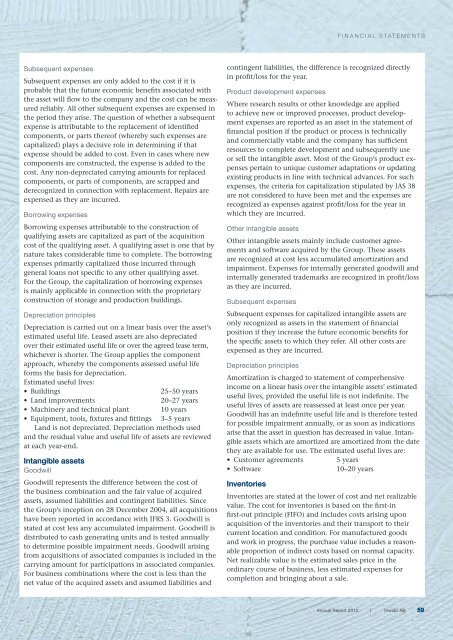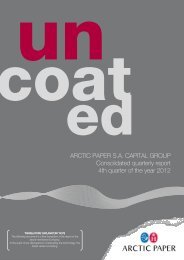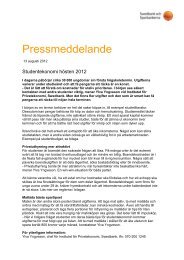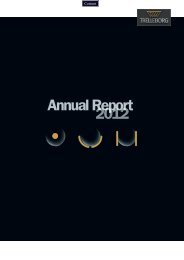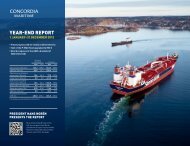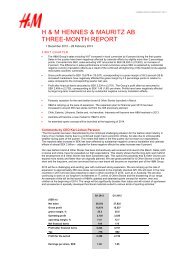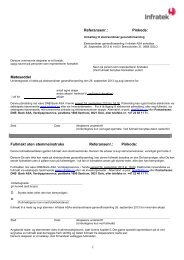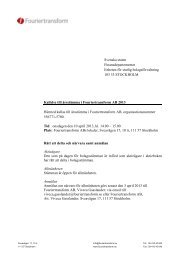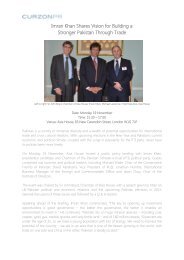Annual Report 2012 - Inwido
Annual Report 2012 - Inwido
Annual Report 2012 - Inwido
You also want an ePaper? Increase the reach of your titles
YUMPU automatically turns print PDFs into web optimized ePapers that Google loves.
FINANCIAL STATEMENTS<br />
Subsequent expenses<br />
Subsequent expenses are only added to the cost if it is<br />
probable that the future economic benefits associated with<br />
the asset will flow to the company and the cost can be measured<br />
reliably. All other subsequent expenses are expensed in<br />
the period they arise. The question of whether a subsequent<br />
expense is attributable to the replacement of identified<br />
components, or parts thereof (whereby such expenses are<br />
capitalized) plays a decisive role in determining if that<br />
expense should be added to cost. Even in cases where new<br />
components are constructed, the expense is added to the<br />
cost. Any non-depreciated carrying amounts for replaced<br />
components, or parts of components, are scrapped and<br />
derecognized in connection with replacement. Repairs are<br />
expensed as they are incurred.<br />
Borrowing expenses<br />
Borrowing expenses attributable to the construction of<br />
qualifying assets are capitalized as part of the acquisition<br />
cost of the qualifying asset. A qualifying asset is one that by<br />
nature takes considerable time to complete. The borrowing<br />
expenses primarily capitalized those incurred through<br />
general loans not specific to any other qualifying asset.<br />
For the Group, the capitalization of borrowing expenses<br />
is mainly applicable in connection with the proprietary<br />
construction of storage and production buildings.<br />
Depreciation principles<br />
Depreciation is carried out on a linear basis over the asset’s<br />
estimated useful life. Leased assets are also depreciated<br />
over their estimated useful life or over the agreed lease term,<br />
which ever is shorter. The Group applies the component<br />
approach, whereby the components assessed useful life<br />
forms the basis for depreciation.<br />
Estimated useful lives:<br />
• Buildings<br />
25–50 years<br />
• Land improvements<br />
20–27 years<br />
• Machinery and technical plant 10 years<br />
• Equipment, tools, fixtures and fittings 3–5 years<br />
Land is not depreciated. Depreciation methods used<br />
and the residual value and useful life of assets are reviewed<br />
at each year-end.<br />
Intangible assets<br />
Goodwill<br />
Goodwill represents the difference between the cost of<br />
the business combination and the fair value of acquired<br />
assets, assumed liabilities and contingent liabilities. Since<br />
the Group’s inception on 28 December 2004, all acquisitions<br />
have been reported in accordance with IFRS 3. Goodwill is<br />
stated at cost less any accumulated impairment. Goodwill is<br />
distributed to cash generating units and is tested annually<br />
to determine possible impairment needs. Goodwill arising<br />
from acquisitions of associated companies is included in the<br />
carrying amount for participations in associated companies.<br />
For business combinations where the cost is less than the<br />
net value of the acquired assets and assumed liabilities and<br />
contingent liabilities, the difference is recognized directly<br />
in profit/loss for the year.<br />
Product development expenses<br />
Where research results or other knowledge are applied<br />
to achieve new or improved processes, product development<br />
expenses are reported as an asset in the statement of<br />
financial position if the product or process is technically<br />
and commercially viable and the company has sufficient<br />
resources to complete development and subsequently use<br />
or sell the intangible asset. Most of the Group’s product expenses<br />
pertain to unique customer adaptations or updating<br />
existing products in line with technical advances. For such<br />
expenses, the criteria for capitalization stipulated by IAS 38<br />
are not considered to have been met and the expenses are<br />
recognized as expenses against profit/loss for the year in<br />
which they are incurred.<br />
Other intangible assets<br />
Other intangible assets mainly include customer agreements<br />
and software acquired by the Group. These assets<br />
are recognized at cost less accumulated amortization and<br />
impairment. Expenses for internally generated goodwill and<br />
internally generated trademarks are recognized in profit/loss<br />
as they are incurred.<br />
Subsequent expenses<br />
Subsequent expenses for capitalized intangible assets are<br />
only recognized as assets in the statement of financial<br />
position if they increase the future economic benefits for<br />
the specific assets to which they refer. All other costs are<br />
expensed as they are incurred.<br />
Depreciation principles<br />
Amortization is charged to statement of comprehensive<br />
income on a linear basis over the intangible assets’ estimated<br />
useful lives, provided the useful life is not indefinite. The<br />
useful lives of assets are reassessed at least once per year.<br />
Goodwill has an indefinite useful life and is therefore tested<br />
for possible impairment annually, or as soon as indications<br />
arise that the asset in question has decreased in value. Intangible<br />
assets which are amortized are amortized from the date<br />
they are available for use. The estimated useful lives are:<br />
• Customer agreements 5 years<br />
• Software<br />
10–20 years<br />
Inventories<br />
Inventories are stated at the lower of cost and net realizable<br />
value. The cost for inventories is based on the first-in<br />
first-out principle (FIFO) and includes costs arising upon<br />
acquisition of the inventories and their transport to their<br />
current location and condition. For manufactured goods<br />
and work in progress, the purchase value includes a reasonable<br />
proportion of indirect costs based on normal capacity.<br />
Net realizable value is the estimated sales price in the<br />
ordinary course of business, less estimated expenses for<br />
completion and bringing about a sale.<br />
<strong>Annual</strong> <strong>Report</strong> <strong>2012</strong> | <strong>Inwido</strong> AB 59


